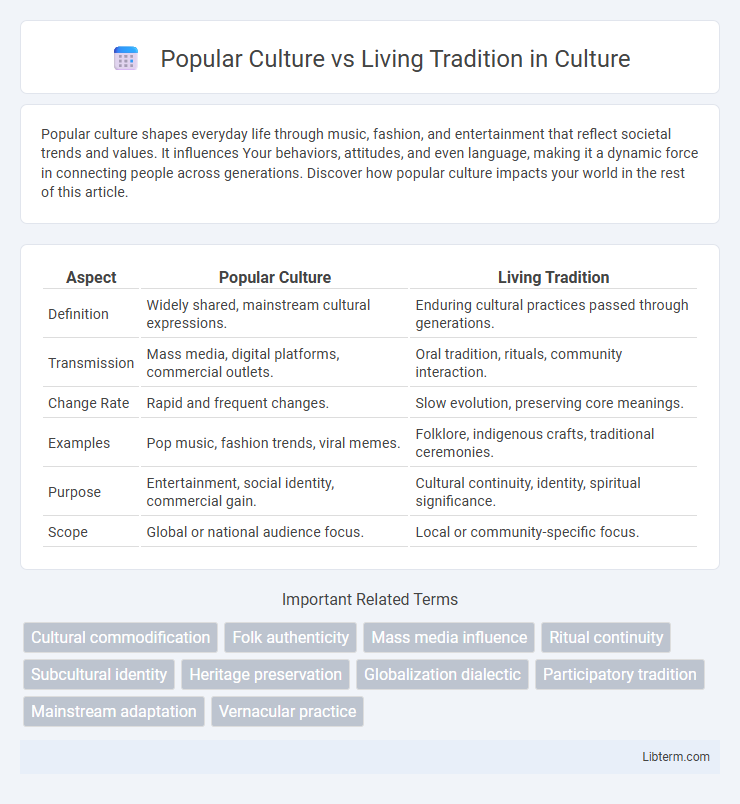Popular culture shapes everyday life through music, fashion, and entertainment that reflect societal trends and values. It influences Your behaviors, attitudes, and even language, making it a dynamic force in connecting people across generations. Discover how popular culture impacts your world in the rest of this article.
Table of Comparison
| Aspect | Popular Culture | Living Tradition |
|---|---|---|
| Definition | Widely shared, mainstream cultural expressions. | Enduring cultural practices passed through generations. |
| Transmission | Mass media, digital platforms, commercial outlets. | Oral tradition, rituals, community interaction. |
| Change Rate | Rapid and frequent changes. | Slow evolution, preserving core meanings. |
| Examples | Pop music, fashion trends, viral memes. | Folklore, indigenous crafts, traditional ceremonies. |
| Purpose | Entertainment, social identity, commercial gain. | Cultural continuity, identity, spiritual significance. |
| Scope | Global or national audience focus. | Local or community-specific focus. |
Defining Popular Culture and Living Tradition
Popular culture encompasses contemporary practices, ideas, and objects widely embraced and disseminated through mass media, entertainment, and social interaction, reflecting the tastes and trends of the current generation. Living tradition refers to cultural customs, rituals, and knowledge continuously practiced and transmitted within a community, maintaining historical continuity and identity across generations. The distinction lies in popular culture's dynamic and globalized nature versus living tradition's rootedness in localized, inherited cultural heritage.
Historical Roots of Popular Culture
Popular culture, with its roots in the early industrial era, emerged from urbanization and mass media, contrasting with living tradition that evolves through continuous communal practices passed down orally and through rituals. The historical development of popular culture reflects commercial influence, mass production, and widespread dissemination via print and electronic media, shaping shared social experiences. Unlike living traditions rooted in localized, inherited customs, popular culture adapts rapidly to societal changes, reflecting diverse, dynamic expressions in music, fashion, and entertainment.
Foundations of Living Tradition
Living tradition is rooted in community values, historical continuity, and the active practice of customs passed down through generations, ensuring cultural identity and social cohesion remain vibrant. Its foundations are anchored in oral transmission, ritual performance, and adaptive resilience, allowing traditions to evolve while preserving core meanings. Unlike popular culture, which is often mass-produced and commercialized, living tradition emphasizes authenticity, collective memory, and the ongoing participation of community members.
Influence of Technology on Cultural Expression
Technology reshapes popular culture by rapidly disseminating trends through digital platforms, enabling instantaneous global access and participation. In contrast, living traditions integrate technology selectively, preserving core cultural expressions while adopting new tools to enhance storytelling, craftsmanship, and ritual practices. The dynamic interaction between digital innovation and cultural heritage fosters evolving expressions without eroding traditional values.
Commercialization: Pop Culture’s Driving Force
Commercialization fuels popular culture by rapidly spreading trends through mass media, transforming local customs into global products. Living traditions resist this commercial pressure by emphasizing authenticity, communal participation, and cultural continuity over market-driven popularity. The clash between profit-driven popularity and heritage preservation highlights the tension between transient consumerism and enduring cultural identity.
Community Roles in Sustaining Traditions
Living traditions thrive through active participation of community elders and cultural practitioners who transmit knowledge orally and through rituals, ensuring continuity across generations. Popular culture, influenced by mass media and commercialization, tends to homogenize cultural expressions but can also raise awareness and appreciation of traditional practices. Community roles in sustaining traditions involve safeguarding customs, languages, and crafts, fostering a sense of identity and belonging amid modern societal changes.
Intersections and Hybridization
Popular culture and living tradition intersect through the continuous exchange of symbols, practices, and narratives, creating dynamic hybrid forms that reflect both contemporary influences and historical roots. This hybridization manifests in music, fashion, and festivals where traditional motifs blend with modern aesthetics, fostering cultural innovation while preserving heritage. Such intersections highlight the fluidity of cultural identity, as communities adapt and reinterpret traditions within popular culture contexts.
Changing Narratives Over Time
Popular culture evolves rapidly, reflecting contemporary trends, technology, and media influence, whereas living traditions maintain core values and practices passed through generations. Changing narratives in popular culture often prioritize novelty and mass appeal, while living traditions adapt slowly, preserving identity and historical continuity. Over time, these differing paces of change highlight the dynamic tension between innovation and cultural heritage.
Challenges to Preservation
Popular culture often faces rapid change driven by mass media and commercialization, posing significant challenges to the preservation of living traditions rooted in community practices and ancestral knowledge. Living traditions struggle with authenticity erosion and loss of cultural context as younger generations gravitate toward globalized, popular cultural forms. Efforts to preserve living traditions demand sustainable cultural policies, active community involvement, and educational programs that reinforce traditional skills and values.
The Future of Cultural Identity
Popular culture continuously evolves by integrating global trends, while living traditions preserve cultural identity through generations with established rituals and practices. The future of cultural identity hinges on balancing these dynamic influences, ensuring that modernization does not erode the authenticity of heritage. Embracing digital platforms and intercultural dialogue can foster a resilient cultural identity that honors both innovation and tradition.
Popular Culture Infographic

 libterm.com
libterm.com